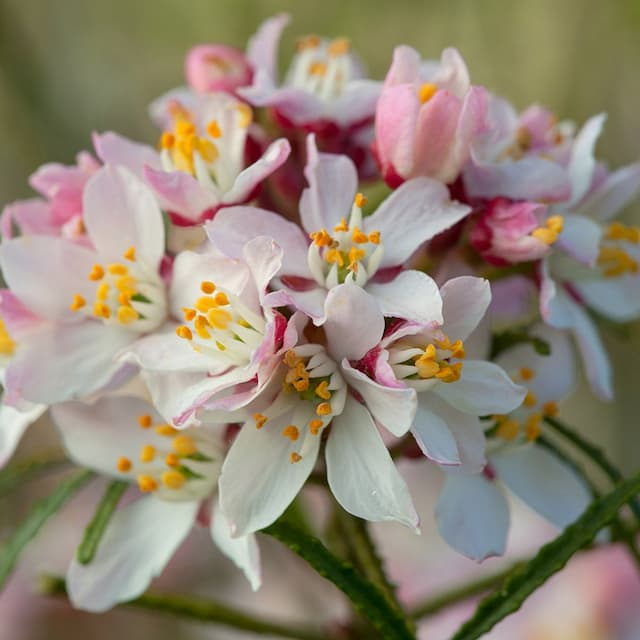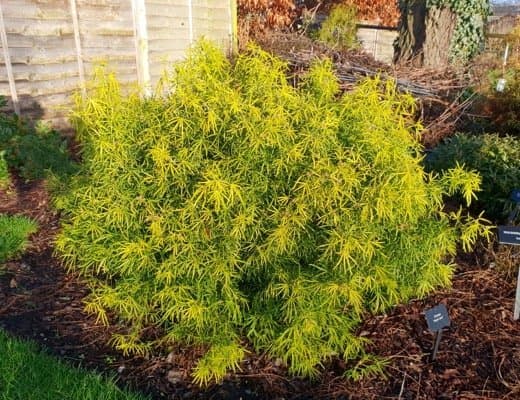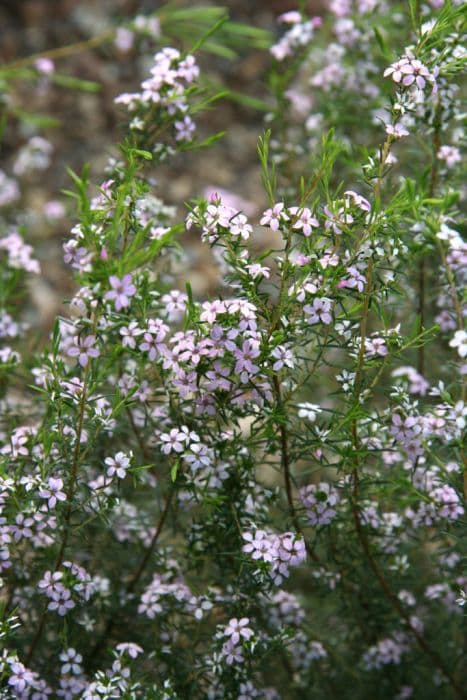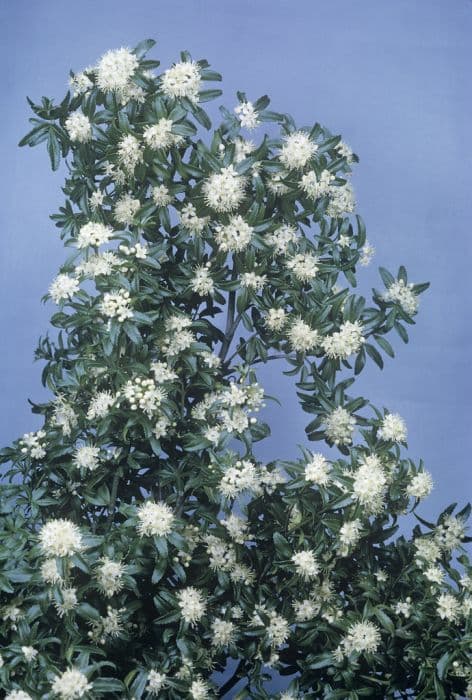Mexican orange 'Aztec Pearl' Choisya × dewitteana 'Aztec Pearl'

ABOUT
'Aztec Pearl' is a small evergreen shrub of open rounded habit, with bright green leaves composed of 3-5 slender leaflets. Flowers to 3cm in width, fragrant, white, tinged pink in bud, in small clusters in late spring, and again in autumn
About this plant
 Names
NamesFamily
Rutaceae.
Synonyms
Aztec Pearl Mexican Orange, Mexican Orange 'Aztec Pearl', Mexican Orange Blossom 'Aztec Pearl'.
Common names
Choisya × dewitteana 'Aztec Pearl'.
 Characteristics
CharacteristicsLife cycle
Perennials
Foliage type
Evergreen
Color of leaves
Dark green
Flower color
White
Height
4-8 feet (1.2-2.4 meters)
Spread
4-8 feet (1.2-2.4 meters)
Plant type
Shrub
Hardiness zones
7
Native area
Mexico
Benefits
 General Benefits
General Benefits- Aesthetic Appeal: 'Aztec Pearl' offers year-round ornamental value with its bright green, glossy, finger-like leaves and a bushy, evergreen habit that provides structure to gardens.
- Fragrant Flowers: It blooms with clusters of fragrant, white flowers in late spring, which are attractive to both humans and beneficial pollinators such as bees and butterflies.
- Drought Tolerance: Once established, 'Aztec Pearl' is known for its drought resistance, making it suitable for xeriscaping or gardens with low water availability.
- Low Maintenance: This plant generally requires minimal care, with occasional pruning to maintain shape, and is tolerant of neglect, which is ideal for busy or novice gardeners.
- Cold Hardy: 'Aztec Pearl' is relatively hardy to cold temperatures, capable of withstanding light frosts which makes it suitable for a range of temperate climates.
- Versatility: It can be used in a variety of garden settings, such as in borders, as a specimen plant, or in container gardens, offering flexibility in garden design.
- Deer Resistant: The plant is somewhat resistant to deer, which makes it a good choice for gardens in areas where deer browsing can be a problem.
 Medical Properties
Medical PropertiesThis plant is not used for medical purposes.
 Air-purifying Qualities
Air-purifying QualitiesThis plant is not specifically known for air purifying qualities.
 Other Uses
Other Uses- Choisya 'Aztec Pearl' can be used in crafting due to its aromatic leaves and easy-to-shape growth habit, making it suitable for inclusion in wreaths and floral arrangements.
- The dense foliage of the Mexican Orange can offer privacy and sound insulation when planted as a hedge in urban gardens.
- Its branches can be used in small woodcrafts, such as making plant stakes or decorative gardening elements, due to their sturdiness.
- Choisya 'Aztec Pearl' can serve as a host plant for certain species of butterflies, providing a habitat and feeding ground for caterpillars.
- Dried leaves of the Mexican Orange may be incorporated into potpourri mixes to add a citrusy scent to a room.
- Garden designers often use the plant for creating geometric patterns in formal gardens, owing to its easily trimmed structure.
- Due to its evergreen nature, the Mexican Orange can be used for themed gardens, such as winter or Christmas gardens, for year-round greenery.
- Photographers might utilize the plant as a backdrop for close-up photography of insects and other small wildlife that are attracted to its flowers.
- The plant's ability to grow in containers makes it a good candidate for movable garden elements, such as living screens or focal points on patios.
- A natural dye can be extracted from the leaves and flowers of the Mexican Orange, although not commonly practiced, for coloring fabrics and crafts.
Interesting Facts
 Feng Shui
Feng ShuiThe Mexican Orange Blossom is not used in Feng Shui practice.
 Zodiac Sign Compitability
Zodiac Sign CompitabilityThe Mexican Orange Blossom is not used in astrology practice.
 Plant Symbolism
Plant Symbolism- **Beauty**: The 'Aztec Pearl' choisya, with its glossy green leaves and fragrant white flowers, is often associated with beauty and aesthetics, representing the allure and sensory delight of nature.
- **Purity**: Its pristine white blooms can symbolize purity and innocence, much like many other white-flowered plants.
- **Simplicity**: The plant's modest growth habit and simple yet elegant flowers can signify a love for the straightforward and uncomplicated things in life.
- **Renewal**: Choisya plants often bloom in spring, a season commonly associated with new beginnings and renewal, mirroring the cyclical nature of life.
- **Protection**: In some cultures, evergreen plants like choisya are believed to ward off evil spirits and are seen as symbols of protection for the home.
 Water
WaterThe Mexican Orange Blossom, or Choisya 'Aztec Pearl', should be watered deeply once a week, ensuring the area around the root zone is thoroughly moistened. During the growing season, in dry or hot weather, increase watering to twice a week. Apply about 1 to 1.5 gallons of water for each watering session, depending on the size of the plant and the soil moisture level. Make sure the plant has well-draining soil to prevent root rot. During the winter, reduce watering, allowing the soil to dry out slightly between waterings, as the plant's water needs decrease.
 Light
LightThe Mexican Orange Blossom thrives in full sun to partial shade. It is best situated in a spot where it receives at least 6 hours of direct sunlight each day, but it can also tolerate some light shade, especially in hotter climates. Avoid deep shade as it may result in fewer flowers and a less dense plant.
 Temperature
TemperatureThe Mexican Orange Blossom prefers a temperate range with ideal temperatures between 65 and 80 degrees Fahrenheit. It can endure minimum temperatures down to around 15 degrees Fahrenheit, but frost can damage the plant. Ensure that it's protected or moved indoors if extreme cold is predicted.
 Pruning
PruningPrune the Mexican Orange Blossom to maintain shape and to promote bushier growth. The best time for pruning is in late spring after the flowering cycle has finished. Pruning can be done annually, but is not required every year unless the plant is overgrown. Cut back any frost-damaged branches in early spring.
 Cleaning
CleaningAs needed
 Soil
SoilMexican Orange 'Aztec Pearl' thrives in a well-draining soil mix with added organic matter. A mixture of garden soil, peat, and perlite or coarse sand would be ideal, allowing for good aeration and drainage. The pH should be slightly acidic to neutral, around 6.0 to 7.5.
 Repotting
RepottingMexican Orange 'Aztec Pearl' should be repotted every 2-3 years to ensure it has enough room to grow. The best time to repot is in the spring, just before the onset of the growing season.
 Humidity & Misting
Humidity & MistingMexican Orange 'Aztec Pearl' prefers moderate humidity levels but is quite adaptable. It does not require any special humidity considerations when planted outdoors in its suitable climate.
 Suitable locations
Suitable locationsIndoor
Place in bright, indirect light and avoid cold drafts.
Outdoor
Plant in well-drained soil, full sun to partial shade.
Hardiness zone
7-10 USDA
 Life cycle
Life cycleThe Mexican Orange 'Aztec Pearl' begins its life cycle as a seed, which when sown in a well-drained soil mix, germinates to produce a small seedling. As the seedling grows, it develops a root system and foliage, eventually forming a bushy evergreen shrub with glossy, aromatic leaves and a rounded habit. During the spring and early summer, 'Aztec Pearl' enters its flowering stage, producing fragrant white flowers that attract pollinators and provide aesthetic value. After pollination, if conditions allow, the flowers may develop into small fruit containing seeds, although this is uncommon in cultivation. The shrub continues to mature, increasing in size and may require pruning to maintain its shape and promote bushier growth. With proper care, 'Aztec Pearl' can live for many years, going through annual cycles of growth and dormancy, with flowering occurring each spring.
 Propogation
PropogationPropogation time
Spring-Early Summer
Choisya 'Aztec Pearl', commonly known as Mexican Orange, is best propagated in the late spring or early summer. The most popular method involves taking semi-ripe cuttings, which are stem pieces that are not fully mature and have a slightly firm texture. To propagate, cut a length of stem about 4 to 6 inches (10 to 15 centimeters) long, ensuring there are at least a couple of leaf nodes. The lower leaves should be removed, and the cut end can be dipped in rooting hormone to encourage root development. The cutting should then be inserted into a pot filled with a mixture of peat and perlite or a similar free-draining propagation medium to ensure adequate moisture without waterlogging. The pot needs to be placed in a warm, shaded spot and covered with a plastic bag or placed in a propagator to maintain high humidity around the cutting. Roots typically develop within a few weeks, after which the cutting can be gradually acclimatized to the outside environment before planting out.









